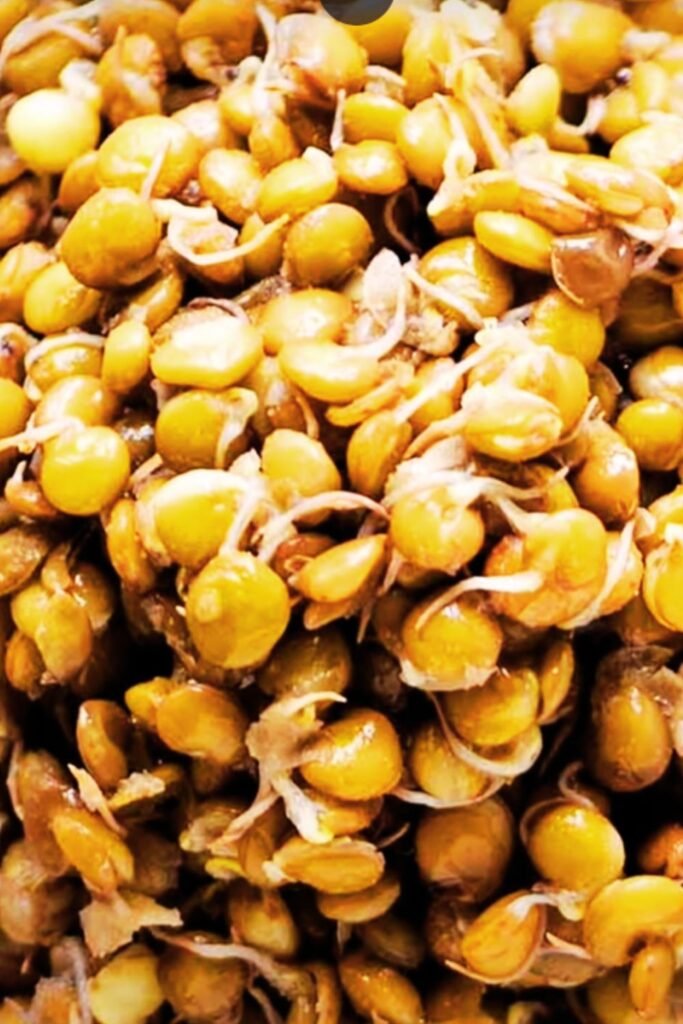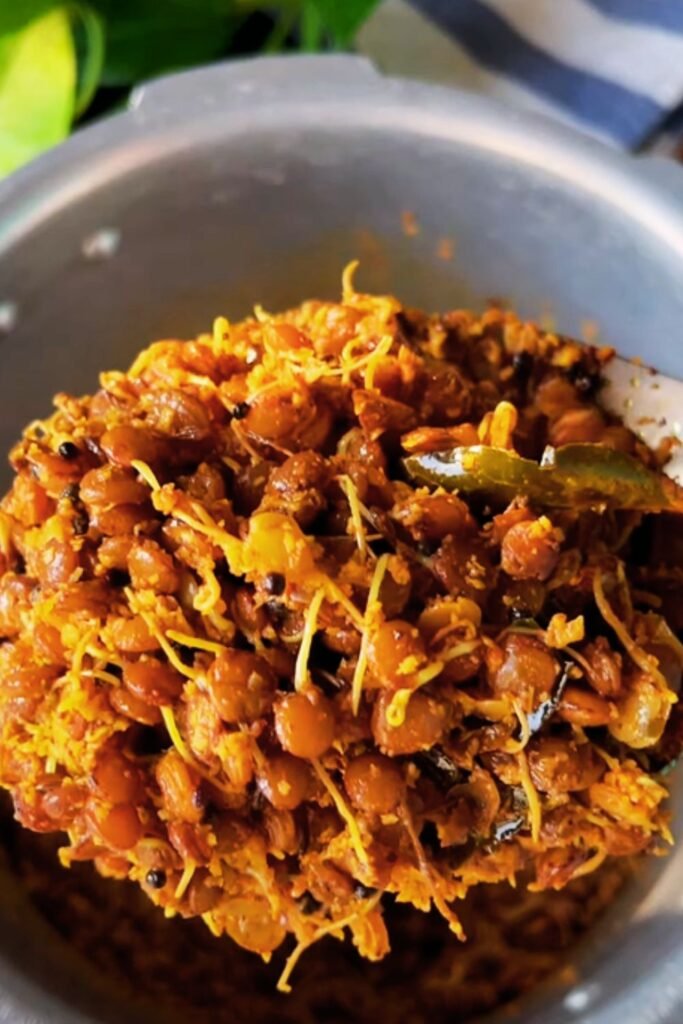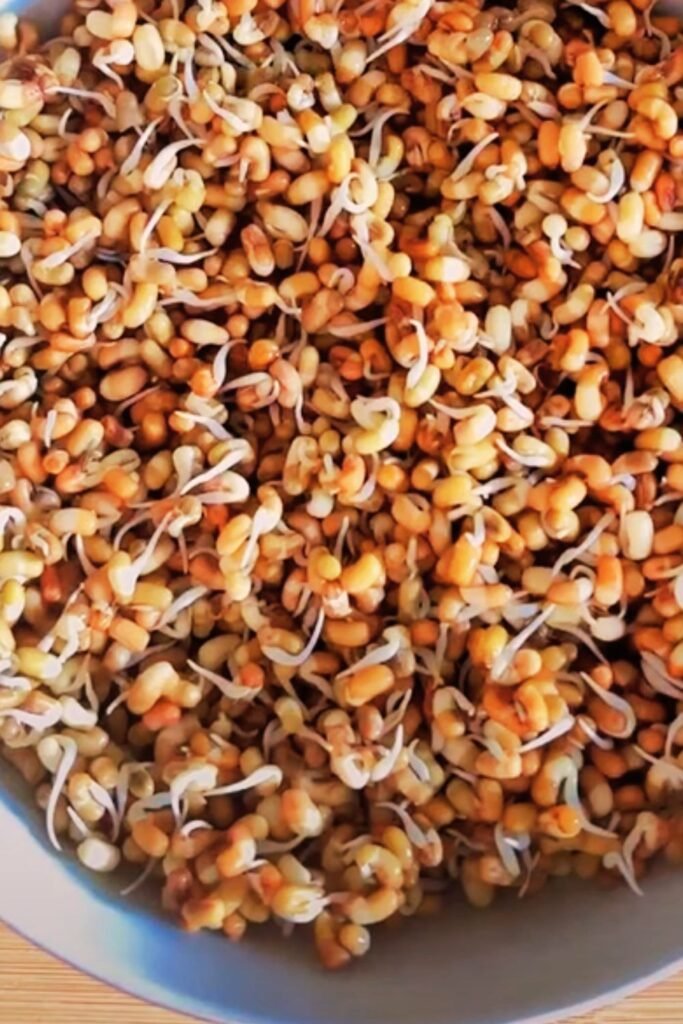When I first discovered sprouted lentils, I was amazed by how something so simple could transform my cooking entirely. These tiny nutritional powerhouses have become a staple in my kitchen, offering incredible health benefits and versatility that never ceases to surprise me. Today, I’m sharing everything I’ve learned about sprouting lentils, from the basic technique to creative recipe variations that will revolutionize your meals.
Sprouted lentils aren’t just trendy health food – they’re a game-changer for anyone looking to boost their nutrition while exploring new flavors and textures. Through years of experimenting in my kitchen, I’ve discovered that sprouting lentils at home is surprisingly straightforward, incredibly cost-effective, and remarkably rewarding.
Understanding Sprouted Lentils: The Foundation of Nutritional Excellence
Sprouted Lentils: Lentils that have begun germination through controlled soaking and moisture exposure, developing small shoots that enhance their nutritional profile and digestibility.
Germination Process: The biological activation that occurs when dormant seeds receive adequate moisture, warmth, and oxygen, triggering enzyme activity and nutrient transformation.
Bioavailability: The degree to which nutrients become accessible and absorbable by the human body, significantly increased through the sprouting process.
Enzyme Activation: The awakening of dormant enzymes within the lentil seed, which breaks down complex proteins and starches into more digestible forms.
The transformation that occurs during sprouting fascinates me every time I witness it. When lentils sprout, their nutrient density increases dramatically while anti-nutritional factors like phytic acid decrease substantially. This process essentially pre-digests the lentils, making them easier on your digestive system and more nutritious overall.
The Science Behind Sprouting: Why I Choose This Method
My journey with sprouted lentils began when I researched the nutritional differences between regular and sprouted legumes. The results were compelling enough to make me a permanent convert to this ancient food preparation technique.
During sprouting, several remarkable changes occur within the lentil. Protein content increases by up to 30%, while vitamin C content can multiply by more than 600%. The sprouting process also reduces cooking time significantly, making these nutrient-dense legumes more accessible for busy weeknight dinners.

Nutritional Comparison: Sprouted vs. Regular Lentils
| Nutrient Component | Regular Lentils (100g) | Sprouted Lentils (100g) | Percentage Increase |
|---|---|---|---|
| Protein | 24.6g | 28.3g | +15% |
| Vitamin C | 4.5mg | 16.5mg | +267% |
| Folate | 479mcg | 547mcg | +14% |
| Iron | 6.5mg | 7.8mg | +20% |
| Magnesium | 122mg | 142mg | +16% |
| Phosphorus | 451mg | 498mg | +10% |
| Potassium | 677mg | 784mg | +16% |
| Digestible Fiber | 10.7g | 12.2g | +14% |
Essential Equipment for Perfect Sprouting
Through trial and error, I’ve identified the essential tools that make sprouting lentils foolproof and enjoyable:
- Wide-mouth glass jars (32oz capacity works perfectly)
- Fine-mesh sprouting lids or cheesecloth with rubber bands
- Large mixing bowl for initial soaking
- Fine-mesh strainer for thorough rinsing
- Clean kitchen towels for covering during sprouting
- Measuring cups for accurate lentil portions
Step-by-Step Sprouting Process: My Proven Method
Day 1: Initial Preparation
I start by selecting high-quality, organic lentils. My preferred varieties for sprouting include green lentils, brown lentils, and black beluga lentils. Red lentils, while delicious, don’t sprout as reliably due to their processing.
Selection Criteria:
- Whole, unbroken lentils
- No visible damage or discoloration
- Organic certification when possible
- Recent harvest date for optimal viability
Initial Soaking Steps:
- Measure 1 cup of dried lentils
- Rinse thoroughly under cold running water
- Remove any damaged or floating lentils
- Place in a large bowl with 3 cups of filtered water
- Cover and let soak for 8-12 hours
Day 2-4: The Sprouting Phase
After the initial soaking period, I drain the lentils and begin the sprouting process. This phase requires attention but minimal actual work.
Morning Routine (Days 2-4):
- Drain soaking water completely
- Rinse lentils thoroughly with cool water
- Transfer to sprouting jar with mesh lid
- Place jar at a 45-degree angle in a bowl
- Cover with a kitchen towel to maintain darkness
- Store at room temperature (68-72°F)
Evening Routine (Days 2-4):
- Rinse lentils thoroughly without removing from jar
- Drain completely by inverting jar
- Return to angled position in bowl
- Re-cover with kitchen towel
Optimal Sprouting Conditions: What I’ve Learned
| Environmental Factor | Ideal Range | My Observations |
|---|---|---|
| Temperature | 68-72°F (20-22°C) | Higher temps speed sprouting but may cause spoilage |
| Humidity | 85-90% | Natural humidity from rinsing usually sufficient |
| Air Circulation | Moderate | Too much dries out sprouts; too little causes mold |
| Light Exposure | Minimal/Dark | Light during sprouting creates bitter flavors |
| Rinsing Frequency | 2x daily | More frequent rinsing in hot weather |

Troubleshooting Common Sprouting Issues
Over the years, I’ve encountered and solved various sprouting challenges. Here’s my troubleshooting guide based on real experience:
Slow or No Sprouting:
- Check lentil age (older lentils sprout poorly)
- Verify water temperature during soaking (too hot kills viability)
- Ensure adequate moisture without oversaturation
- Consider seasonal variations in sprouting success
Mold Development:
- Increase rinsing frequency immediately
- Improve air circulation around sprouting container
- Reduce ambient temperature if possible
- Start fresh batch with sterilized equipment
Bitter or Off Flavors:
- Minimize light exposure during sprouting
- Ensure proper drainage between rinses
- Harvest earlier in sprouting cycle
- Check water quality (chlorinated water can cause issues)
My Favorite Sprouted Lentil Recipe
Classic Sprouted Lentil Salad
Ingredients:
- 2 cups fresh sprouted lentils
- 1 medium cucumber, diced
- 2 medium tomatoes, chopped
- 1/2 red onion, finely minced
- 1/4 cup fresh parsley, chopped
- 2 tablespoons fresh mint, chopped
- 3 tablespoons extra virgin olive oil
- 2 tablespoons fresh lemon juice
- 1 teaspoon ground cumin
- 1/2 teaspoon smoked paprika
- Salt and black pepper to taste
- 1/4 cup toasted sunflower seeds
Preparation Method:
- Blanch the Sprouts: Bring a large pot of salted water to boil. Add sprouted lentils and cook for 2-3 minutes until just tender but still firm. Drain and rinse with cold water to stop cooking.
- Prepare Vegetables: While lentils cool, dice cucumber and tomatoes uniformly. Mince red onion finely to avoid overwhelming the delicate lentil flavor.
- Create Dressing: Whisk together olive oil, lemon juice, cumin, and smoked paprika in a large mixing bowl. Season with salt and pepper to taste.
- Combine Ingredients: Add cooled lentils, prepared vegetables, and fresh herbs to the dressing. Toss gently but thoroughly to ensure even coating.
- Final Assembly: Let salad rest for 15 minutes to allow flavors to meld. Garnish with toasted sunflower seeds just before serving.
Recipe Variations: Expanding Your Sprouted Lentil Repertoire
Mediterranean-Style Sprouted Lentils
I love preparing this variation when I want something reminiscent of sunny Mediterranean afternoons:
Key Additions:
- Kalamata olives, pitted and halved
- Crumbled feta cheese
- Sun-dried tomatoes, chopped
- Fresh oregano and basil
- Red wine vinegar in the dressing
Asian-Inspired Sprouted Lentil Bowl
This fusion creation has become a weeknight favorite in my household:
Flavor Profile:
- Sesame oil and rice vinegar dressing
- Fresh ginger and garlic
- Shredded carrots and purple cabbage
- Cilantro and scallions
- Toasted sesame seeds for crunch
Warm Sprouted Lentil Curry
Perfect for cooler weather, this recipe transforms sprouted lentils into comfort food:
Cooking Method:
- Sauté onions, ginger, and spices
- Add sprouted lentils with coconut milk
- Simmer until heated through
- Finish with fresh cilantro and lime

Storage and Preservation: Maximizing Your Sprouted Lentils
Proper storage ensures my sprouted lentils maintain their nutritional value and fresh taste for maximum enjoyment.
Refrigerated Storage:
- Store in perforated plastic bags or ventilated containers
- Use within 3-5 days for optimal freshness
- Rinse before use if storing longer than 2 days
- Keep temperature between 32-40°F
Freezing Guidelines:
- Blanch sprouts for 2 minutes before freezing
- Cool completely and drain thoroughly
- Package in freezer bags with date labels
- Use within 6 months for best quality
Health Benefits: Why I’m Passionate About Sprouted Lentils
The health benefits of sprouted lentils extend far beyond basic nutrition. Through my research and personal experience, I’ve identified several compelling reasons to include them regularly in your diet.
Digestive Health: The sprouting process breaks down complex sugars that can cause digestive discomfort, making these lentils gentler on sensitive stomachs.
Blood Sugar Management: The increased fiber content and modified starch structure help stabilize blood glucose levels more effectively than regular lentils.
Cardiovascular Support: Enhanced folate and potassium levels contribute to heart health and healthy blood pressure maintenance.
Antioxidant Activity: Sprouting increases antioxidant compounds, providing better protection against cellular damage.
Serving Suggestions: Creative Ways to Enjoy Sprouted Lentils
My creativity with sprouted lentils continues expanding as I discover new applications for these versatile ingredients:
Breakfast Applications:
- Mixed into morning smoothie bowls
- Incorporated into vegetable omelets
- Added to overnight oats for protein boost
- Blended into breakfast grain bowls
Lunch Ideas:
- Stuffed into whole grain pita pockets
- Tossed with quinoa and roasted vegetables
- Mixed into hearty soups and stews
- Used as protein base for Buddha bowls
Dinner Options:
- Incorporated into grain pilafs and risottos
- Mixed into pasta salads and grain salads
- Used as filling for stuffed vegetables
- Added to curry dishes and dal preparations
Snack Applications:
- Seasoned and dehydrated for crunchy snacks
- Mixed into trail mix combinations
- Blended into homemade hummus variations
- Used in energy ball recipes
Seasonal Adaptations: Year-Round Sprouted Lentil Success
I’ve learned to adapt my sprouting technique based on seasonal conditions for consistent results throughout the year.
Spring Sprouting (March-May)
- Moderate temperatures create ideal conditions
- Natural humidity levels support sprouting
- Fresh herbs abundantly available for recipes
- Perfect season for light, refreshing preparations
Summer Sprouting (June-August)
- Increased rinsing frequency prevents spoilage
- Cooler indoor locations for sprouting jars
- Cold preparations preferred over warm dishes
- Abundant fresh vegetables enhance recipes
Fall Sprouting (September-November)
- Stable temperatures return for easy sprouting
- Heartier preparations suit cooling weather
- Root vegetables complement sprouted lentils well
- Ideal time for preserving and freezing surplus
Winter Sprouting (December-February)
- Consistent indoor temperatures benefit sprouting
- Warm preparations provide comfort during cold weather
- Stored vegetables and herbs maintain variety
- Sprouted lentils provide fresh nutrition when produce is limited
Quality Assessment: Ensuring Perfect Sprouted Lentils
| Quality Indicator | Excellent Quality | Acceptable Quality | Poor Quality |
|---|---|---|---|
| Sprout Length | 1/4 to 1/2 inch | 1/8 to 1/4 inch | Less than 1/8 inch |
| Color | Bright, vibrant | Slightly dull | Brown or black spots |
| Smell | Fresh, slightly sweet | Neutral | Sour or musty |
| Texture | Firm, crisp | Slightly soft | Mushy or slimy |
| Uniformity | 80%+ sprouted | 60-80% sprouted | Less than 60% sprouted |
Advanced Techniques: Taking Your Sprouting to the Next Level
After mastering basic sprouting, I’ve explored advanced techniques that produce even better results:
Temperature Control: Using a sprouting heating mat maintains consistent 70°F temperatures for optimal germination rates.
pH Monitoring: Testing water pH and adjusting to 6.0-7.0 range improves sprouting success and reduces spoilage risk.
Variety Blending: Mixing different lentil varieties creates interesting textures and flavors while spreading harvest timing.
Microgreen Transition: Allowing some sprouts to develop into microgreens provides additional nutritional benefits and culinary applications.
Questions and Answers
Q: How long does it take for lentils to sprout completely? A: In my experience, lentils typically develop visible sprouts within 24-48 hours, with optimal harvest occurring between days 2-4. The exact timing depends on temperature, humidity, and lentil variety.
Q: Can I eat sprouted lentils raw? A: Yes, sprouted lentils are safe to eat raw and offer maximum nutritional benefits in their uncooked state. I often enjoy them raw in salads and cold preparations, though brief blanching can improve digestibility for some people.
Q: What’s the difference between sprouting green versus brown lentils? A: Green lentils tend to maintain their shape better during sprouting and offer a slightly firmer texture, while brown lentils sprout more quickly but can become softer. Both varieties work excellently for sprouting with similar nutritional benefits.
Q: How do I know if my sprouted lentils have gone bad? A: Signs of spoilage include sour or musty odors, slimy texture, dark discoloration, or visible mold growth. Fresh sprouted lentils should smell clean and slightly sweet with a firm, crisp texture.
Q: Can I sprout lentils in winter when my kitchen is cooler? A: Absolutely! I successfully sprout lentils year-round by placing sprouting jars in slightly warmer locations like on top of the refrigerator or near (not on) heating vents. The process may take an extra day in cooler conditions.
Q: Is it necessary to use organic lentils for sprouting? A: While not absolutely necessary, I prefer organic lentils for sprouting because they haven’t been treated with sprouting inhibitors and typically have better germination rates. The investment in quality often results in more successful sprouting.
Q: How much do lentils expand during the sprouting process? A: Sprouted lentils roughly double in volume from their dried state. I typically start with 1 cup of dried lentils to yield approximately 2 cups of sprouted lentils, perfect for most recipes.
Q: Can I speed up the sprouting process? A: While I don’t recommend rushing the natural process, maintaining optimal temperature (70°F), using filtered water, and ensuring proper drainage can help achieve maximum sprouting efficiency within the natural timeframe.
Sprouted lentils have transformed my approach to healthy eating by providing incredible nutrition, versatility, and satisfaction in every meal. The simple process of sprouting unlocks enhanced bioavailability of nutrients while creating ingredients that are both delicious and nourishing. Whether you’re new to sprouting or looking to expand your technique, these methods and recipes will help you create restaurant-quality dishes in your own kitchen.
The journey from dried lentil to sprouted superfood exemplifies how traditional food preparation techniques can enhance our modern nutritional needs. I encourage you to experiment with different varieties, seasonings, and preparations to discover your personal favorites. The reward of creating these nutritious ingredients from scratch, combined with their incredible versatility, makes sprouted lentils an invaluable addition to any health-conscious kitchen.